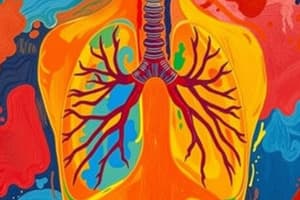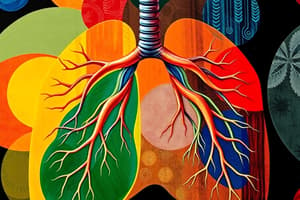Podcast
Questions and Answers
Where does glycolysis take place in a cell?
Where does glycolysis take place in a cell?
- Cytoplasm (correct)
- Cell membrane
- Nucleus
- Mitochondria
Which stage of cellular respiration involves the production of a net gain of 2 ATP molecules and 2 NADH molecules?
Which stage of cellular respiration involves the production of a net gain of 2 ATP molecules and 2 NADH molecules?
- Electron Transport Chain
- Glycolysis (correct)
- Oxidative Phosphorylation
- Krebs Cycle
In cellular respiration, Acetyl-CoA is produced from which molecule?
In cellular respiration, Acetyl-CoA is produced from which molecule?
- Pyruvate (correct)
- ATP
- Glucose
- FADH2
What is the main function of the Electron Transport Chain in cellular respiration?
What is the main function of the Electron Transport Chain in cellular respiration?
What is the approximate energy yield in terms of ATP molecules from one molecule of glucose during cellular respiration?
What is the approximate energy yield in terms of ATP molecules from one molecule of glucose during cellular respiration?
Which process breaks down complex molecules to release chemical energy?
Which process breaks down complex molecules to release chemical energy?
What is the main reason why glycolysis is considered obligatory in cellular respiration?
What is the main reason why glycolysis is considered obligatory in cellular respiration?
Which factor influences the rate of cellular respiration by dictating the availability of glucose and oxygen?
Which factor influences the rate of cellular respiration by dictating the availability of glucose and oxygen?
What occurs when ATP levels are high during cellular respiration?
What occurs when ATP levels are high during cellular respiration?
In the absence of oxygen, some organisms can produce ATP by fermenting glucose to which compound?
In the absence of oxygen, some organisms can produce ATP by fermenting glucose to which compound?
Study Notes
Exploring Respiration in 10th Class Biology
Respiration, a fundamental biological process, is a vital aspect of life for all living organisms. In the context of 10th class biology, we'll explore the concept of cellular respiration—the process by which living cells extract energy from chemical compounds, primarily glucose, and convert it into usable form (ATP) to fuel cellular activities.
Cellular Respiration: The Big Picture
Cellular respiration occurs in three main stages:
-
Glycolysis: This stage takes place in the cytoplasm, where a molecule of glucose is broken down into two molecules of pyruvate, producing a net gain of 2 ATP molecules and 2 NADH molecules.
-
Krebs Cycle (Citric Acid Cycle): In the mitochondria, pyruvate is transformed into Acetyl-CoA, which enters the Krebs cycle. Here, Acetyl-CoA goes through a series of reactions to generate more NADH and FADH2 molecules, along with 1 ATP molecule per cycle.
-
Electron Transport Chain and Oxidative Phosphorylation: The NADH and FADH2 molecules from glycolysis and the Krebs cycle are used in the electron transport chain, which pumps protons across the inner mitochondrial membrane. This generates a proton gradient that drives the synthesis of ATP molecules in a process called oxidative phosphorylation.
Energy Yield
The energy yield from cellular respiration is approximately 36-38 ATP molecules per molecule of glucose (depending on the efficiency of the process). The majority of this energy (32-34 ATP) is generated in the electron transport chain.
Anabolic and Catabolic Pathways
Cellular respiration is an example of catabolism, which breaks down complex molecules to release chemical energy. Conversely, anabolism constructs complex molecules from simpler ones using energy released from catabolism.
Obligatory Glycolysis and Optional Oxidative Phosphorylation
Glycolysis is obligatory—it must occur to initiate the process of cellular respiration. Oxidative phosphorylation, however, is optional. Some organisms, such as yeast and bacteria, can ferment glucose to lactic acid or ethanol (in the absence of oxygen) to produce ATP without oxidative phosphorylation.
Regulation of Cellular Respiration
Cellular respiration is regulated by various factors, including:
-
Feedback inhibition: When ATP levels are high, the enzyme pyruvate kinase is inhibited, decreasing glycolysis and sparing glucose until it's needed.
-
Allosteric regulation: Enzymes in the glycolytic pathway may be regulated by allosteric effectors, such as ATP and citrate.
-
Substrate availability: The availability of glucose and oxygen will dictate the rate of cellular respiration.
Environmental Impact on Respiration
Cellular respiration is influenced by environmental factors, such as temperature, pH, and the availability of oxygen. As a result, the rate of cellular respiration will change to meet the energy demands of the organism under different environmental conditions.
In conclusion, respiration—specifically, cellular respiration—is a critical process that provides cells with the energy they need to function. Throughout your studies, investigate the intricate details of this process, the regulation mechanisms that govern it, and the environmental factors that impact respiration.
Studying That Suits You
Use AI to generate personalized quizzes and flashcards to suit your learning preferences.
Description
Delve into the concept of cellular respiration in 10th class biology, understanding the stages of glycolysis, the Krebs cycle, electron transport chain, energy yield, anabolic and catabolic pathways, regulation, and environmental influences on respiration.




